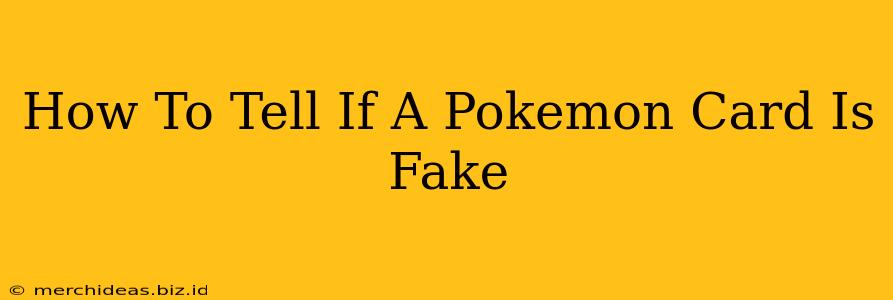The world of Pokemon card collecting is booming, but with increased popularity comes a rise in counterfeit cards. Knowing how to spot a fake is crucial to protecting your investment and ensuring your collection's authenticity. This guide will equip you with the knowledge to distinguish genuine Pokemon cards from cleverly crafted imitations.
Visual Inspection: The First Line of Defense
The most straightforward method for identifying fake Pokemon cards involves a careful visual examination. Look for inconsistencies and discrepancies that often betray a counterfeit.
1. Card Stock and Texture:
- Genuine Cards: Possess a specific thickness and texture; they're firm, slightly glossy, and have a subtle stiffness. They rarely feel flimsy or overly thin.
- Fake Cards: Often feel thinner, more flexible, or even slightly rough. The gloss can appear unnatural or overly shiny.
2. Print Quality and Color:
- Genuine Cards: Exhibit crisp, sharp printing with vibrant, consistent colors. The images are clear and well-defined.
- Fake Cards: Frequently display blurry images, faded colors, misaligned printing, or uneven color saturation. Look closely for pixelation or a smeared look, particularly in areas with gradients.
3. Font and Text:
- Genuine Cards: The fonts used on official Pokemon cards are consistent and precise. Text is clear and easily legible. Pay attention to the style and spacing of letters and numbers.
- Fake Cards: Often use slightly off fonts, inconsistent spacing, or blurry text. The font might look slightly different compared to genuine cards of the same set.
4. Holographic Foils (Holo Cards):
- Genuine Cards: Holographic foils are vibrant, detailed, and three-dimensional. They shouldn't appear overly flat or dull. The shine is consistent and even.
- Fake Cards: Fake holos often lack the depth and sparkle of genuine cards. The foil may look faded, pixelated, or have a plasticky, unnatural sheen. The rainbow effect might be uneven or blotchy.
5. Examine the Edges and Corners:
- Genuine Cards: Have cleanly cut and smooth edges. Corners are usually sharp and well-defined, without any fraying or imperfections.
- Fake Cards: Might show rough or uneven cuts, blurry edges, or rounded corners. Look for any imperfections or signs of amateur cutting.
Beyond the Visual: Advanced Techniques
While visual inspection is a great starting point, more advanced techniques can help confirm your suspicions.
1. Check for the Pokemon Card Logo:
Carefully scrutinize the Pokemon logo on the card. Fake cards often have a slightly altered or distorted logo compared to authentic ones.
2. Compare to Authentic Examples:
If you have other authentic Pokemon cards from the same set, compare the suspect card to them side-by-side. Look for inconsistencies in size, texture, font, or holographic features.
3. Utilize Online Resources:
Numerous websites and online communities dedicated to Pokemon card collecting provide resources and guides to help identify fake cards. Use reputable sources and compare your card to known authentic examples.
Protecting Yourself from Counterfeit Cards
- Buy from Reputable Sellers: Purchase cards from trusted online marketplaces or established local game stores.
- Be Wary of Deals That Seem Too Good to Be True: If a deal seems suspiciously cheap, it might be a red flag.
- Ask Questions: Don't hesitate to contact sellers for more information and high-resolution images of the cards before purchasing.
By employing these methods, you can significantly improve your ability to detect fake Pokemon cards and protect your valuable collection. Remember, a thorough inspection is key to ensuring the authenticity of your prized possessions.
